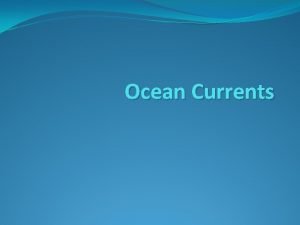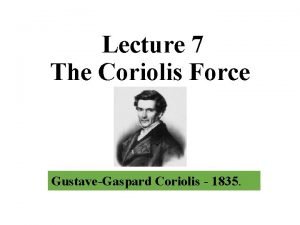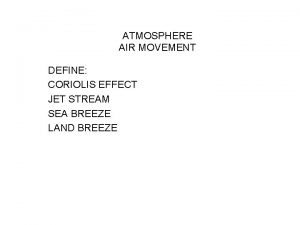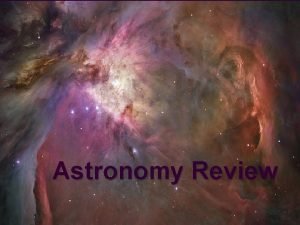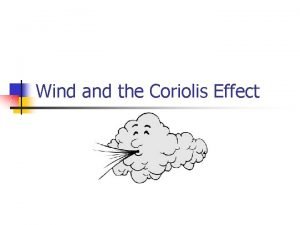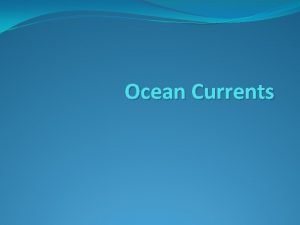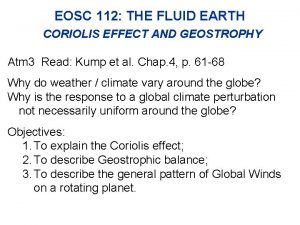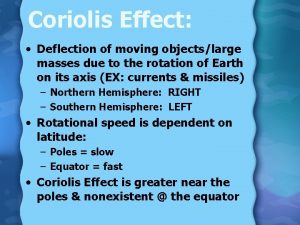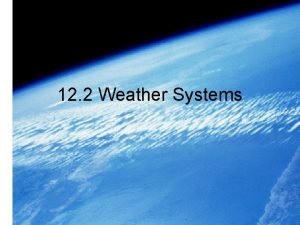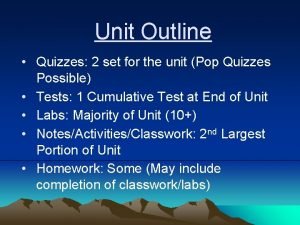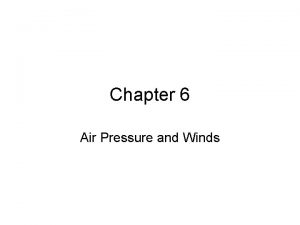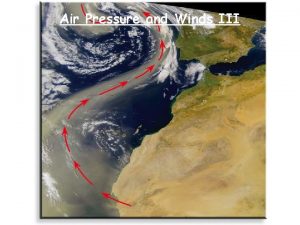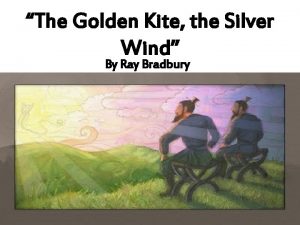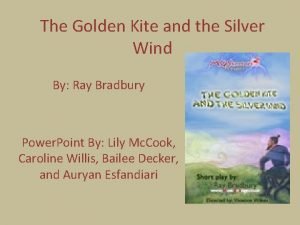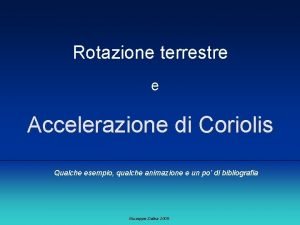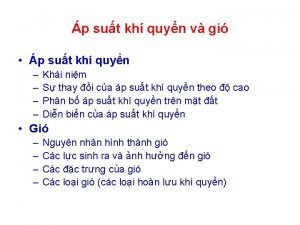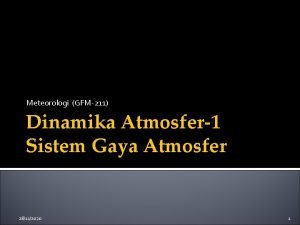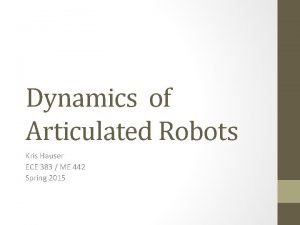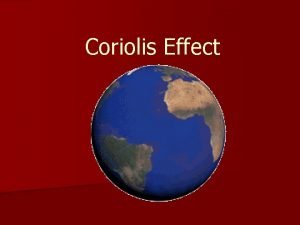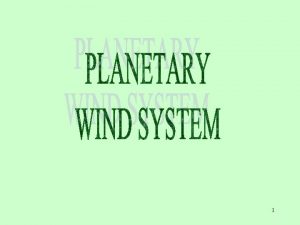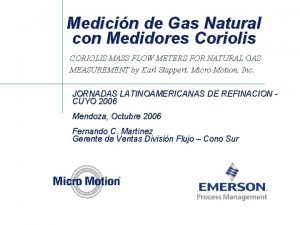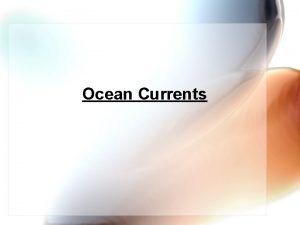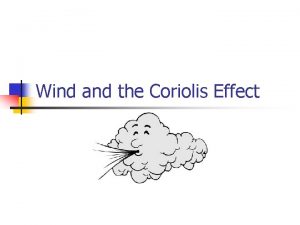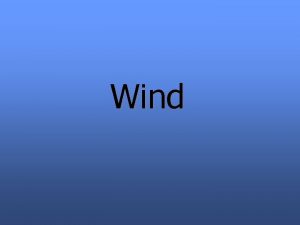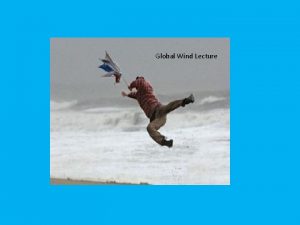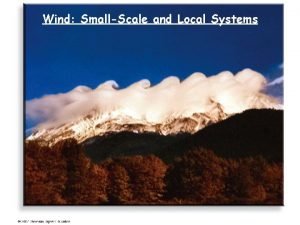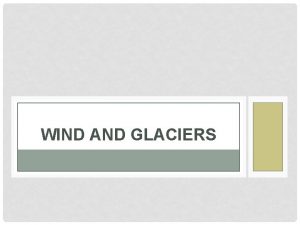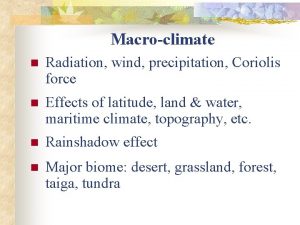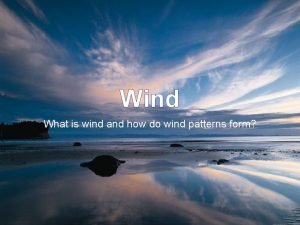Wind and the Coriolis Effect n n n



















- Slides: 19

Wind and the Coriolis Effect

n n n Air pressure differences cause the movement of air Air moving parallel to the ground is called wind Air moving up or down is called a current

n Air generally moves from the poles to the equator, this is because air flows from high pressure to low pressure n n n High pressure forms when cold air sinks (at the poles) Low pressure forms when warm air rises (at the equator) But the air doesn’t flow in a straight line

Coriolis Effect n n Causes air to move in a curved path It is caused by the Earth spinning on its axis The Earth spins fastest at the equator, and slowest near the poles As air moves from the equator to the pole, it will travel east faster than the land beneath it causing the air to follow a curved path

n n n So the coriolis effect causes wind flowing from high pressure to low pressure to curve as the wind moves In the Northern Hemisphere, the coriolis effect causes things to curve to the Right In the Southern Hemisphere, the coriolis effect causes things to curve to the Left

Wind n n Winds are created because of the uneven heating the Earth As discussed before, air moves from high pressure to low pressure n n n Areas that are warmer are low pressure areas, so wind blows toward low pressure Areas that are colder are high pressure areas, so wind blows away from high pressure There are two types of winds n n Planetary (or global) local

Planetary wind n n These winds blow across the entire planet They generally blow at the same speed and direction Some are high in the atmosphere and you cannot feel them on the ground Each hemisphere contains 3 wind belts that divide up the planetary winds n Trade winds, Westerlies, and Easterlies

Trade winds n n n Blow toward the equator, an area of low pressure called Doldrums Located between 0 -30º north and south Called trade winds because many European sailors used these winds for trade

Trade winds cont. n n In northern hemisphere, trade winds come from the NE, so they are called Northeast trade winds In the southern hemisphere, trade winds come from the SE, so they are called Southeast trade winds *Notice the Coriolis Effect at work*

Westerlies n n n Between 30º and 60º latitude High pressure at 30º causes air to descend and blow toward the poles This zone of high pressure at 30º are called Horse Latitude

Westerlies cont. n n In northern hemisphere, westerlies are southwest winds In the southern hemisphere, westerlies are northwest winds

Polar Easterlies n n Located above 60º latitude (between 6090º) High pressure over the poles (caused by the sinking cold dense air) causes the air to blow away from the poles toward 60º latitude

Polar Easterlies cont. n n At north pole, they are northeast winds since the wind comes from the northeast At the south pole, they are southeast winds since the wind comes from the southeast

Planetary Wind Shift n n Because the Earth goes through seasons throughout the year, the wind belts can shift slightly But the average shift is only about 10º

Local Winds n n These winds blow over small areas Unlike planetary winds, local winds can change speed and direct frequently These are the winds we feel on the ground They are influenced by local conditions and local temperature variations

Local Wind cont. n Land sea breezes n During the day, the land heats up faster than the water, so a breeze will blow from the sea to the land, called a sea breeze

Local winds cont. n At night, the land will cool off faster than the water, so the cool land air will flow toward the warmer ocean water air, creating a land breeze, where the wind blows from the land to the sea

Local Winds cont. n Mountain and Valley Breezes n During the day, the valley heats up, so the warm less dense air flows up the mountain, creating a valley breeze

Local winds cont. n At night, the mountain will cool off faster than the valley, so the cool mountain air descends because it is more dense, creating a mountain breeze
 Ocean currents vocabulary
Ocean currents vocabulary Coriolis effect formula
Coriolis effect formula Define coriolis effect
Define coriolis effect The coriolis effect provides evidence that
The coriolis effect provides evidence that What is coriolis effect caused by
What is coriolis effect caused by Ocean currents vocabulary
Ocean currents vocabulary Eosc 112
Eosc 112 Coriolis effect animation
Coriolis effect animation What is coriolis effect caused by
What is coriolis effect caused by Quizzes
Quizzes Raumschotkurs
Raumschotkurs Japan
Japan Pgf and coriolis force
Pgf and coriolis force Silver wind meaning
Silver wind meaning The golden kite, the silver wind summary
The golden kite, the silver wind summary Accelerazione di coriolis
Accelerazione di coriolis Lực coriolis
Lực coriolis Contoh soal gaya coriolis
Contoh soal gaya coriolis Coriolis matrix
Coriolis matrix Coriolis acceleration
Coriolis acceleration
